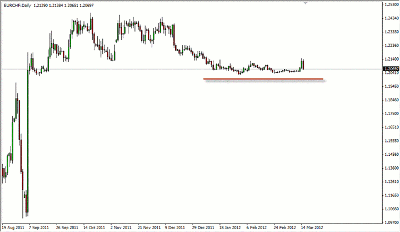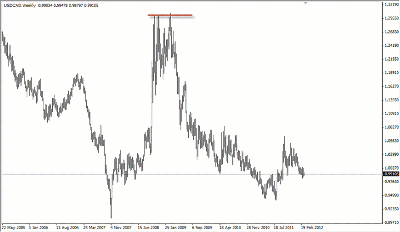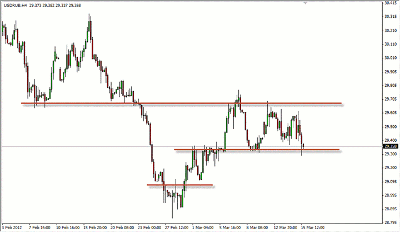Christopher Lewis, contributor to DailyForex.com, cites real market examples that show how support and resistance on the charts can help even non-technical traders predict future price action in forex.
The absolutely most common and basic of all tools used in technical analysis is the concept of support and resistance. It is so common that even traders who aren't necessarily technical by nature are often heard quoting where support or resistance can be found. This is also expressed by the expressions "Where buyers are stepping into the market," or conversely, "Where sellers are stepping into the market."
Looking at support, it is exactly what it sounds like: a spot where the price of a financial instrument is "supported," or in other words, where the pair has trouble getting below a certain point.
For example, you may notice on the below chart that the EUR/CHF pair has trouble getting below the 1.20 level. This is support in this pair, and the longer it goes on, the larger the amount of traders who then feel comfortable buying at that level. It rapidly becomes a self-fulfilling prophecy at this point, and as such, it is a good place to think about buying the pair.
Alternatively, there are times when the market cannot seem to break through a price to the upside. In this instance, it is called "resistance." In other words, the market is resisting price at that point.
See also: Forex Basics: Trading Currency Pairs
This runs on the same premise as support, only in reverse. It is simply a place where large amounts of sellers feel that the pair or instrument is overvalued and are willing to speculate that the price is going to fall. Again, it becomes a self-fulfilling prophecy after enough of these failures to break price. A great example of this was during 2008-2009 in the USD/CAD at the 1.30 level.
You must keep in mind that nothing is 100% reliable. Just because price has caused a reaction in previous attempts doesn't mean it has to going forward. Simply put, you are speculating that it will again, and by using these levels, you are increasing your odds of success.
Increasing the likelihood of your trade working out is essentially what trading is all about and therefore, support and resistance are the essence of forex trading.
NEXT: Expected Behavior When Support or Resistance Is Broken
|pagebreak|Another interesting phenomenon of support and resistance is that it tends to reverse itself when broken. What this means simply is that a level that is broken through will often act as support later. The same is true of support that gives way, as it will often act as resistance later.
One especially easy way to think of this is like you would a high-rise building. If you are on the first floor, the ceiling (resistance) keeps you from getting to the second floor. However, if you go around the ceiling via the stairs, you are now on the second floor. That same plane that was your ceiling is now the floor, and is now supporting your weight, keeping you from falling back to the first floor. Naturally, this works in both directions.
Of special note is the fact that larger support and resistance levels tend to focus on large, "round numbers" such as 1.20, 1.10, 1.00, and 50. In most markets, you will see these whole numbers cause reactions to price again and again.
As an exercise, try drawing horizontal lines every 500 pips on your charts on the weekly time frame, using these types of numbers as a guide. So for the EUR/USD pair, you would draw them at 1.25, 1.30, 1.35, and so on. By experimenting with these numbers, the concept should become much clearer to you over time.
As with all things related to technical analysis, the longer the time frame, the more reliable something is. This is especially true with support and resistance.
You will often see charts where traders talk about support and resistance on short-term charts, but remember, it takes much more in the way of trades to make a support or resistance level appear on the weekly than it does a 15-minute chart, and such a trend may be a stronger indicator of where to trade profitably.
See related: How to Get Started in Chart Reading
By Christopher Lewis, contributor, DailyForex.com
Christopher Lewis is a contributor to DailyForex.com and has been trading forex for several years. He writes about forex for many online publications, including his own site, The Trader Guy.














